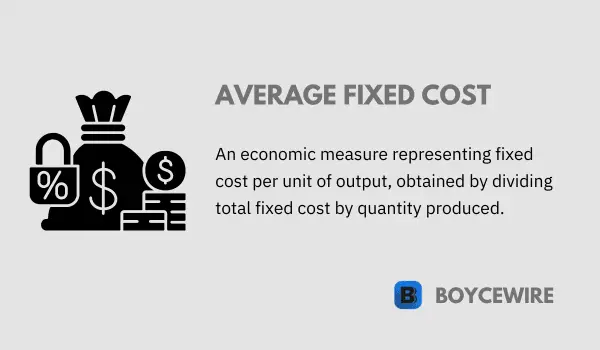Average Fixed Cost: Definition, Formula & Examples

What is an Average Fixed Cost?
In economics and business decision-making, understanding costs is crucial to optimizing operations, maximizing profits, and ensuring sustainability. Among various cost metrics, the average fixed cost (AFC) stands as a vital measure. It represents the fixed costs of production spread over the number of units produced, decreasing as output increases and playing an essential role in comprehending economies of scale and the cost behavior of a business.
Fixed costs refer to the expenses that a business incurs regardless of its level of output. These include costs like rent, salaries, and insurance, which need to be paid even if production temporarily halts. By examining the average fixed cost, firms can gain insight into how efficiently they’re utilizing their fixed resources and make strategic decisions accordingly.
Key Points
- Average fixed cost (AFC) is the total fixed cost divided by the quantity of output.
- AFC decreases as the quantity of output increases because fixed costs are spread over a larger number of units.
- AFC represents the fixed cost per unit of output and provides insights into the cost structure of a business.
Understanding Average Fixed Cost
Average fixed cost (AFC) is a component of the total cost of production and represents the cost of using the fixed inputs, or the overhead costs, per unit of output. Fixed costs are costs that do not vary with the level of output. Examples include rent for the production facility, salaries of permanent employees, and the cost of machinery and equipment.
In contrast to variable costs, which change in response to the volume of goods or services produced, fixed costs remain constant regardless of production levels. Even if production halts temporarily, these costs continue to accrue because they are independent of output. Consequently, AFC plays a crucial role in a company’s pricing and production decisions.
The nature of the average fixed cost curve is unique. It is a rectangular hyperbola, which means that the product of the quantity of output and AFC at all levels of output remains the same, and equals total fixed costs.
Another distinctive aspect of AFC is its behavior. As production increases, the AFC decreases due to the spreading effect. This spreading effect is the essence of the concept of economies of scale, which means that the larger the scale of production, the lower the cost per unit of output. Therefore, a thorough understanding of the AFC concept is vital for businesses to operate efficiently and competitively.
Calculation of Average Fixed Cost
Calculating the average fixed cost (AFC) involves a straightforward process. Here are the steps:
- Identify Fixed Costs First, determine all the fixed costs associated with production. These are costs that remain the same irrespective of the level of production. Examples can include the cost of machinery, rent for the production facility, insurance, and salaries of permanent staff.
- Compute Total Fixed Costs Add up all identified fixed costs to get the total fixed cost.
- Determine Quantity of Output Identify the total number of goods or units produced.
- Calculate Average Fixed Cost Finally, divide the total fixed cost by the number of units produced to get the AFC.
Mathematically, this can be represented as:
Average Fixed Cost (AFC) = Total Fixed Cost / Quantity of Output
As production increases, the average fixed cost decreases due to the spreading of fixed costs over a larger number of goods or units produced. This gives a downward sloping AFC curve, representing the principle of economies of scale. However, once production stops or declines, the AFC begins to rise again because the fixed costs are spread across fewer units of output.
It’s important to note that while calculating the AFC, only fixed costs are considered. Variable costs, which change with the level of production, do not influence it.
Average Fixed Cost Curve
The average fixed cost (AFC) curve is a graphical representation of the relationship between the AFC and the quantity of output produced. It’s a crucial tool in understanding the behavior of fixed costs as production levels vary.
The AFC curve has several distinctive characteristics:
- Shape The AFC curve is downward sloping, reflecting the inverse relationship between AFC and the quantity of output. As output increases, AFC decreases because the same total fixed cost is spread over a larger number of units. This is the principle of spreading overhead.
- Starting Point The curve starts from a point on the vertical axis (quantity = 0), representing the high fixed cost per unit when production is minimal or just starting.
- Asymptotic Behavior The AFC curve approaches, but never reaches, the horizontal axis. This is because no matter how much output increases, fixed costs can never become zero, so the average fixed cost will always be a positive number. However, as output grows very large, the AFC becomes very small, so the curve comes closer and closer to the horizontal axis.
- No Positive Slope The AFC curve does not slope upwards because fixed costs don’t increase with output – they are fixed.
In summary, the AFC curve provides visual insight into how fixed costs behave with changes in production output. This information can be critical in production decision-making, allowing businesses to identify the most cost-effective level of production and better manage their fixed costs.
Advantages of Average Fixed Costs
Understanding average fixed costs (AFC) provides several benefits in the realm of business and economics, particularly for firms seeking to optimize their production levels:
- Improved Decision-Making Understanding AFC allows firms to make informed decisions about production and pricing. For example, if a business understands that its AFC will decrease with increased production, it may decide to produce more to spread out its fixed costs.
- Cost Control AFC provides an understanding of how fixed costs are distributed per unit of output. This knowledge can help firms monitor and control their costs more effectively.
- Price Setting Knowledge of AFC can help businesses set the right price for their goods or services. By knowing the AFC, a business can ensure that the price of a product covers the average fixed cost per unit, in addition to variable costs and desired profit.
- Optimal Scale of Production Understanding AFC can help a firm identify the optimal scale of production. If the AFC is still significantly high, it might be advantageous to increase production levels to lower the AFC.
- Performance Comparison Firms can use AFC as a benchmark to compare performance over different periods or to compare with other firms in the industry. It can serve as an indicator of operational efficiency.
In summary, a comprehensive understanding of AFC can significantly aid in business strategy and planning, facilitating more efficient operations and better financial performance.
Disadvantages and Limitations of Average Fixed Costs
While understanding average fixed costs (AFC) offers many benefits, it is important to also consider its limitations and potential drawbacks:
- Imperfect Measurement Fixed costs often involve long-term commitments like rent or machinery, which can be difficult to adjust in the short run. Therefore, calculating AFC may not accurately reflect a company’s capacity for short-term cost reduction.
- Decreasing Relevance with Scale AFC becomes less relevant for decision-making as production volume increases, as the AFC per unit becomes increasingly small. It is more crucial in the early stages of production or for smaller businesses.
- Simplicity of the Concept The concept of AFC is very simplified and does not take into account the complexities of real-world businesses, such as changes in technology, sudden fluctuations in demand, or other external factors that can affect fixed costs.
- Dependence on Output AFC depends heavily on the level of output, which can be unpredictable and vary over time. This can make it difficult for firms to accurately calculate and rely on AFC for strategic decisions.
- Ignorance of Variable Costs AFC only considers fixed costs, ignoring variable costs that also play a significant role in production decisions. A comprehensive cost analysis should consider both fixed and variable costs.
Despite these limitations, AFC remains an important concept in understanding a firm’s cost structure. However, it should be used in conjunction with other financial metrics and indicators to make sound business decisions.
Examples of Average Fixed Costs
- A Local Bakery Suppose a local bakery has monthly fixed costs of $2000, which include rent, equipment depreciation, and salaried staff wages. In one month, the bakery produces 1000 loaves of bread. Thus, the AFC per loaf is $2000/1000, or $2 per loaf.
- A Manufacturing Plant A manufacturing plant has fixed costs of $10,000 per month, including the cost of leasing the factory, salaried employees, and machinery maintenance. If the plant produces 5000 units of a product in a month, the average fixed cost per unit of product is $10,000/5000, which equals $2 per unit.
- A Software Company A software company has fixed costs of $50,000 per month, including office rent, salaries of permanent staff, and costs for software licenses. If they deliver 10 software projects in a month, the AFC per project is $50,000/10, or $5000 per project.
Remember, the AFC per unit will decrease as more units are produced because the total fixed cost is spread over a larger number of units. This is known as spreading the overhead, which is the principle behind economies of scale.
FAQs
AFC represents the fixed cost per unit of output.
AFC decreases as the quantity of output increases because fixed costs are spread over a larger number of units.
AFC provides insights into the portion of costs that remain constant regardless of the level of output.
AFC is inversely related to economies of scale, meaning that larger production volumes lead to lower average fixed costs.
About Paul
Paul Boyce is an economics editor with over 10 years experience in the industry. Currently working as a consultant within the financial services sector, Paul is the CEO and chief editor of BoyceWire. He has written publications for FEE, the Mises Institute, and many others.

Further Reading
 Cartel - A cartel in economics is an organization or group of firms that collude to restrict competition and control market prices…
Cartel - A cartel in economics is an organization or group of firms that collude to restrict competition and control market prices…  Prospect Theory: Definition & Examples - Prospect theory is based upon the premise that individuals value losses and gains differently.
Prospect Theory: Definition & Examples - Prospect theory is based upon the premise that individuals value losses and gains differently.  Degrees of Freedom - Degrees of freedom refers to the number of independent variables or data points that can vary in statistical analysis.
Degrees of Freedom - Degrees of freedom refers to the number of independent variables or data points that can vary in statistical analysis. 
